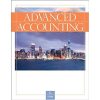Solution Manual Advanced Accounting 4th Edition Solution by Jeter
CHAPTER 2
Note: The letter A indicated for a question, exercise, or problem means that the question, exercise, or problem relates to a chapter appendix.
ANSWERS TO QUESTIONS
- At the acquisition date, the information available (and through the end of the measurement period) is used to estimate the expected total consideration at fair value. If the subsequent stock issue valuation differs from this assessment, the Exposure Draft (SFAS 1204-001) expected to replace FASB Statement No. 141R specifies that equity should not be adjusted. The reason is that the valuation was determined at the date of the exchange, and thus the impact on the firm’s equity was measured at that point based on the best information available then.
- Pro forma financial statements (sometimes referred to as “as if” statements) are financial statements that are prepared to show the effect of planned or contemplated transactions.
- For purposes of the goodwill impairment test, all goodwill must be assigned to a reporting unit. Goodwill impairment for each reporting unit should be tested in a two-step process. In the first step, the fair value of a reporting unit is compared to its carrying amount (goodwill included) at the date of the periodic review. The fair value of the unit may be based on quoted market prices, prices of comparable businesses, or a present value or other valuation technique. If the fair value at the review date is less than the carrying amount, then the second step is necessary. In the second step, the carrying value of the goodwill is compared to its implied fair value. (The calculation of the implied fair value of goodwill used in the impairment test is similar to the method illustrated throughout this chapter for valuing the goodwill at the date of the combination.)
- The expected increase was due to the elimination of goodwill amortization expense. However, the impairment loss under the new rules was potentially larger than a periodic amortization charge, and this is in fact what materialized within the first year after adoption (a large impairment loss). If there was any initial stock price impact from elimination of goodwill amortization, it was only a short-term or momentum effect. Another issue is how the stock market responds to the goodwill impairment charge. Some users claim that this charge is a non-cash charge and should be disregarded by the market. However, others argue that the charge is an admission that the price paid was too high, and might result in a stock price decline (unless the market had already adjusted for this overpayment prior to the actual writedown).
2 – 1
ANSWERS TO BUSINESS ETHICS CASE
a and b. The board has responsibility to look into anything that might suggest malfeasance or inappropriate conduct. Such incidents might suggest broader problems with integrity, honesty, and judgment. In other words, can you trust any reports from the CEO? If the CEO is not fired, does this send a message to other employees that ethical lapses are okay? Employees might feel that top executives are treated differently.
ANSWERS TO EXERCISES
Exercise 2-1
|
Part A |
Receivables |
228,000 |
|
Inventory |
396,000 |
|
|
Plant and Equipment |
540,000 |
|
|
Land |
660,000 |
|
|
Goodwill ($2,154,000 – $1,824,000) |
330,000 |
|
|
Liabilities |
594,000 |
|
|
Cash |
1,560,000 |
|
|
Part B |
Receivables |
228,000 |
|
Inventory |
396,000 |
|
|
Plant and Equipment |
540,000 |
|
|
Land |
660,000 |
|
|
Liabilities |
594,000 |
|
|
Cash |
990,000 |
|
|
Gain on Business Combination ($1,230,000 – $990,000) |
240,000 |
2 – 2
|
Exercise 2-2 |
|||
|
Cash |
$680,000 |
||
|
Receivables |
720,000 |
||
|
Inventories |
2,240,000 |
||
|
Plant and Equipment (net) ($3,840,000 $720,000) |
4,560,000 |
||
|
Goodwill |
120,000 |
||
|
Total Assets |
$8,320,000 |
||
|
Liabilities |
1,520,000 |
||
|
Common Stock, $16 par ($3,440,000 (.50 |
$800,000)) |
3,840,000 |
|
|
Other Contributed Capital ($400,000 $800,000) |
1,200,000 |
||
|
Retained Earnings |
1,760,000 |
||
|
Total Equities |
$8,320,000 |
||
Entries on Petrello Company’s books would be:
|
Cash |
200,000 |
|
|
Receivables |
240,000 |
|
|
Inventory |
240,000 |
|
|
Plant and Equipment |
720,000 |
|
|
Goodwill * |
120,000 |
|
|
Liabilities |
320,000 |
|
|
Common Stock (25,000 |
$16) |
400,000 |
|
Other Contributed Capital ($48 – $16) 25,000 |
800,000 |
|
- ($48 25,000) – [($1,480,000 – ($800,000 – $720,000) – $320,000]
-
- $1,200,000 – [$1,480,000 – $80,000 – $320,000] = $1,200,000 – $1,080,000 = $120,000
2 – 3
|
Exercise 2-3 |
|||
|
Accounts Receivable |
231,000 |
||
|
Inventory |
330,000 |
||
|
Land |
550,000 |
||
|
Buildings and Equipment |
1,144,000 |
||
|
Goodwill |
848,000 |
||
|
Allowance for Uncollectible Accounts ($231,000 – $198,000) |
33,000 |
||
|
Current Liabilities |
275,000 |
||
|
Bonds Payable |
450,000 |
||
|
Premium on Bonds Payable ($495,000 – $450,000) |
45,000 |
||
|
Preferred Stock (15,000 |
$100) |
1,500,000 |
|
|
Common Stock (30,000 |
$10) |
300,000 |
|
|
Other Contributed Capital ($25 – $10) 30,000 |
450,000 |
||
|
Cash |
50,000 |
||
|
Cost paid ($1,500,000 $750,000 $50,000) = |
$2,300,000 |
||









Reviews
There are no reviews yet.